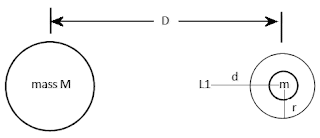I like math, and I strongly suspect Bret Sheppard does not, so I thought I'd do Bret's homework (assigned by myself) for him.
To prove:
In a two-body system in which the smaller body is in tidal lock with the larger body, the radius of a synchronous orbit around the smaller body will always be greater than the distance to the L1 libration point.
Consider a two-body system separated by distance D.
Let M be the mass of the larger body (kg)
Let m be the mass of the smaller body (kg)
Let T be the orbital period of the smaller body about the larger body (sec)
Let r be the radius of a synchronous satellite orbit round the smaller body (m)
Let d be the distance from the smaller body to the L1 libration point (m)
Calculation:
For the smaller body's orbit, by Kepler's third law:
T = 2π √ (D3/GM) where G is the gravitational constant
Since the smaller body is in tidal lock with the larger body, the rotational period of the smaller body must also be T, and so must be the orbital period of a synchronous satellite.
So for the synchronous orbit:
T = 2π √(r3/Gm)
r3/Gm = T2/4π2
Substituting for T
r3 = 4π2GmD3/4π2GM
r = 3√(D3Gm/GM) = D 3√(m/M)
By a simplified formula for d, the distance of the L1 libration point
d = D 3√(m/3M) reference
Therefore d < r, Q.E.D.
The significance of this is that, for a tidally-locked moon, a synchronous orbit is impossible since a satellite would prefer to orbit the parent body. Therefore, anyone who claims to have found a satellite dish on the moon is mathematically full of shit. Thank you.
NOTE:
For the Earth-Moon system, m/M = 0.012 r = 88,465 km d = 61,135 km

5 comments:
I was talking with a former astronaut, who told me about how as a college student, he was assigned to write software, as if for Space missions. He took a look at the programming for the Moon missions, and found a flaw. It turns out that if something had gone wrong, and some sort of course corrections needed to be made, that they wouldn't have had the necessary fuel that they thought was in reserve. His corrections were then made for the benefit of future NASA missions.
Thanks for the math effort, Expat.
Pedantic alert: the proposed satellite dish, even when assuming its particular meaning as a specific type of parabolic antenna could still communicate for whatever reason with various Earth orbit based satellites or any other artificial object in brief Moon orbit or approach. But more likely it would have been used as a more generic parabolic antenna perhaps to pick up some deep space chatter.
Dee: I've got that covered. In those cases it wouldn't be a satellite dish, would it? Gotcha!
HI expat, I got that covered in my initial reply as well :-)
Any artificial (or perhaps even any smaller object) in Earth or Moon orbit, even temporary, would qualify as satellite. And as such any parabolic antenna designed to pick up something from that could still be called a satellite dish.
Generally I think Shephard's intention with the word was clear. And he doesn't believe in being careful with the details in any case. Scientific expressionism of some sorts?
To make it more interesting we could involve frozen orbits although the proposed location of the dish might not be that logical in those cases (27°, 50°, 76°, 86°) -- but I didn't investigate it too deeply. I'd more think of a receiver for Earth centered tsignals as possible utility for a moon based dish.
This was not meant to undo any of your great math exercise of course!
Well, you live and learn eh? I didn't know about frozen orbits.
Also the Russians have (or used to have) a few non-synchronous comsats. Obviously they only work for a small part of each day.
Glad you appreciate my LEET MATH SKILLZ.
Post a Comment